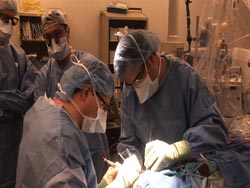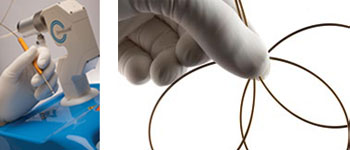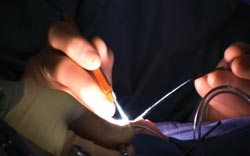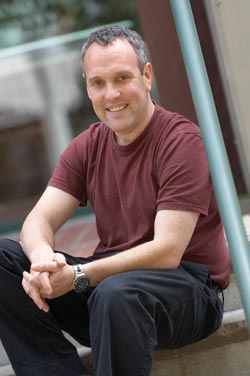While Minimizing Brain Injury
Drs. Bernard Bendok and Andrew Fishman at Northwestern Memorial Hospital in Chicago reported in January that they had become among the first surgeons in the world to use the Beampath Neuro laser system from OmniGuide Inc. of Cambridge, Mass.
Although surgeons recognized the potential of the CO2 laser 30 years ago, the laser beam could travel only at a straight angle from a bulky generator. Unlike these early systems, the Beampath Neuro laser system can remove tumors from hard-to-reach areas of the brain because the CO2 laser is equipped with a flexible optical fiber. The fiber fits directly into a handpiece that is held just like a pencil, and it also is compatible with endoscopes.

Drs. Bernard Bendok and Andrew Fishman perform brain surgery using the Beampath Neuro.
Fishman and Bendok treated a 70-year-old male patient who had a plum-size tumor attached to one of the major veins at the base of the brain, an area typically hard to reach. Even though the tumor was attached to a main blood vessel, the physicians were able to remove it safely because the laser beam coagulates blood vessels. “Using the scalpel would have caused a stroke,” Fishman said in a CNN interview. “Instead, we used [a] CO2 laser to melt the tumor and then shave it off.” The entire operation took less than an hour, and the patient recovered, went home and returned to his daily routine in just five days.
Also unlike steel scalpels, the fiber-enabled CO2 laser beam can remove the tumor from sensitive brain tissue with pinpoint accuracy and without any solid parts of the laser touching brain tissue.

As shown at left, the fiber-coupled handpiece of the laser system is held like a pencil. At right, loops of the fiber are being held. One can see that the fiber is long and thin.
Whereas other types of lasers can penetrate tissue too deeply, CO2 lasers interact with the tissue surface in a unique way that enables surgeons to cleanly remove the tumor from sensitive brain tissue or strip the tumor layer by layer.
The development of this optical fiber started when MIT professor Yoel Fink was himself a PhD student at MIT. He joined a project to develop the perfect mirror, one that reflects any light of any wavelength at any angle without absorbing it.
He and his colleagues decided to use tightly stacked, micron-thin layers of a semiconducting glass and an insulating polymer to make this mirror. They discovered that they could make the mirror reflect any electromagnetic energy at any wavelength by varying the thickness of the layers.
In the Dec. 12, 2002, issue of Nature, the researchers reported that they made optical fibers using the same alternating layers that were used to make the mirror. According to Fink, this was the first time anyone had demonstrated continuous transmission of a CO2 laser beam through an optical fiber. FDA approval came eventually, and Fink co-founded OmniGuide.
The company began marketing the laser to eye, ear, nose and throat (EENT) and head-and-neck surgeons. Today, the company markets laser systems for gynecology and brain and spine surgery as well. “This is the most highly precise optical scalpel that we know of,” Fink said in an interview with BioPhotonics magazine.
Return on the investment
“This is definitely the time when the need to fund basic research is not obvious or accepted,” Fink said. He pointed out that the Beampath Neuro evolved from a basic research project to develop a layered mirror for military and telecommunications.

Doctors use the Beampath system to perform surgery on a tongue.
If it were not for critical funding from the US Department of Defense, this laser surgery tool probably would not be available today. The project was funded by DARPA, which specializes in making ideas happen in just five years when they are believed to be 25 years from fruition, according to Fink.
Today, doctors do 150 to 200 surgeries a week. “It’s saving lives day in and day out,” Fink said. “Our revenues are growing in leaps and bounds even in the current economic state.” So, there has been a short return on the investment.
Soon the engineers plan to publish on transistors in the fibers, which could enable next-generation computing systems. “You could in fact in principle create logic devices, light emitters,” he said, “You could integrate tens of thousands of transistors into a single fiber.”
Man Behind the Machine
Before co-founding a successful technology company and becoming a professor at a world-class university, Yoel Fink traveled in the Far East, braved the Alaskan frontier and served in the Israeli army, leaving with the rank of commander. He saw front-line combat. “You were guaranteed to [fight]; the Middle East has never been a peaceful place,” he said.

Yoel Fink and his colleagues invented the Beampath system.
However, he was otherwise reluctant to speak about his service, which he noted was compulsory. “We’re into saving lives now,” he said.
He loves the outdoors and makes regular visits to Alaska, but the 42-year-old professor experiences plenty of adventure at home. “I have four kids; that’s pretty extreme,” he said, laughing.